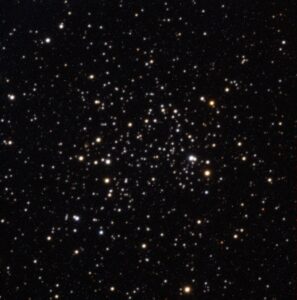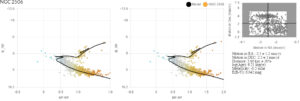“NGC 2506 (also known as Caldwell 54) is an intermediate age cluster in the equatorial constellation of Monoceros. It was discovered by William Herschel in 1791 and has at least 97 probable members. It shows indications of mass segregation, with the lower mass members being more likely to be in the outer parts of the cluster. This is the result of exchange of kinetic energy during encounters between the members.(NGC 2506)
In a recent study, Barbara J et al (2018) determined that there are 12 blue stragglers that are known. Fourteen Gamma Doradus variables, two detached eclipsing binaries, and three Delta Scuti stars have been to be found in the star cluster. They also determined that the cluster is metal poor compared to our sun.
Reddened

De-Reddened:

In order to study Star clusters and investigate the relationships between the colors, brightness’s, and the age and chemical composition of the cluster as a whole, I collected 15 images in the B, V, and R filters with the prompt 5, and PROMPT-MO-1 telescopes using Skynet . The total exposure durations were, 76.92, 38.46, and 25.64 seconds with the B, V, and R filters respectively on the PROMPT-MO-1 telescopes, and 73.17, 36.59, and 24.39 seconds with the B, V, and R filters respectively on the prompt 5 telescopes using Skynet. I used Afterglow to find every star in the photos and measure their brightness. I then put that data into cluster pro plus to determine the distance, proper motion, age, metallicity, and reddening which turned out to be 3.66+-20%, Ra: -2.5+-1.5 DEC: 2.2+-3, 9.21log(yr), -0.2 solar metallicity.
I had to use Gaia and 2mass data to fit the model because my collected data was scattered and didn’t make a clear curve, which made it difficult to make an accurate decision. I learned that the star cluster is metal poor in comparison to our own solar system. I also found nine blue stragglers in the data and a fair few giants. I was also able to make a color image
A study by Kharchenko et al (2013), who found the parameters that I used resulted in extremely similar values to mine where the age and metallicity were pretty much the same but I believe my values were a bit more accurate as it fits the giant branch a little better
Study:

My Result:

Overall, I enjoyed the process of finding data independently and turning it into something useful. It was fun problem solving when data doesn’t turn out what you want and trying to make it usable. I’m glad that I have the opportunity to share my findings with everyone and prove to myself that research doesn’t have to be boring, it can be fun too.